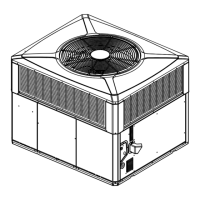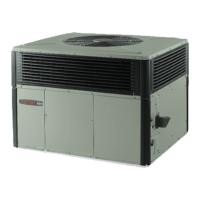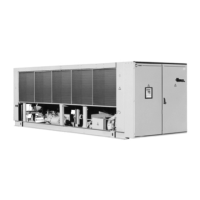
Do you have a question about the Trane 4YCZ5024F1060A and is the answer not in the manual?
Key safety warnings including hazardous gases, voltage, chemical exposure, and refrigerant handling.
Read manual before installation, operation, or maintenance. For qualified technicians only.
Check unit for damage upon unloading, verify nameplate, refrigerant charge, and included parts.
Procedure for recharging the system by measuring liquid line temperature and pressure.
Procedure for evacuating and weighing in charge for temperatures below 55°F OD.
Guidelines for selecting and installing units with horizontal airflow, including clearances and ducting.
Guidelines for selecting and installing units with down airflow, including curb installation.
Recommendations for unit clearances to ensure proper operation and prevent coil starvation.
Instructions for attaching the flue hood to the unit using provided screws.
Steps for installing the unit on a pad at ground level, including level mounting and clearances.
Procedures for installing the unit on a roof curb, including converting airflow and curb preparation.
Safety procedures and guidelines for properly lifting and rigging the unit for installation.
Instructions for positioning the unit onto the roof mounting curb and securing it.
Procedure for installing the unit on a field-fabricated frame for rooftop applications.
Steps for installing the unit on sleeper rails for rooftop applications, without a curb or frame.
Guidelines for connecting downflow ductwork to the roof curb before unit placement.
Procedures for connecting downflow ductwork to a roof frame, including canvas connectors.
Instructions for connecting horizontal ductwork, including insulation and flexible connections.
Precautions for gas piping installation, including pressure limits and system isolation during testing.
Guidelines for determining and adjusting gas supply line pressure to meet unit requirements.
Procedure to check and verify the manifold pressure at the unit's gas valve.
Steps to clock the gas meter and adjust input based on gas flow rate and heating value.
Information on installation at high altitudes and how ratings are affected.
Instructions for installing air filters, including filter types, sizes, and resistance ratings.
Safety warnings and procedures for electrical wiring, grounding, and connections.
Covers electrical power requirements, disconnect switch, overcurrent protection, power wiring, and grounding.
Guidelines for low voltage control wiring, thermostat connections, and resistance limits.
Instructions for setting the thermostat heat anticipator and checking electrical connections.
A checklist of items to verify before starting the unit, covering location, ductwork, piping, wiring, and safety.
Procedure for starting the unit in cooling mode by setting the thermostat.
Description of the unit's heating cycle operation, including thermostat control and burner ignition.
Step-by-step procedure to start the unit in gas heating mode, including gas supply and thermostat settings.
Description of automatic heating and cooling cycles and fan operation modes.
Explanation of the cooling cycle operation for 2-stage thermostats, including compressor and fan engagement.
A comprehensive checklist to ensure all installation steps are completed and the unit is ready for operation.
Tasks the owner can perform, including filter replacement, cabinet cleaning, and general inspection.
Recommended periodic checks by a qualified technician for cooling and heating seasons.
Procedure for cleaning the flue hood and combustion blower, including safety precautions.
How to adjust ECM fan motor speed using dip switches on the control box.
Graphs showing discharge and suction pressure curves for cooling performance based on outdoor temperature.
Table detailing indoor fan performance (CFM) at various motor speeds and external static pressures.
Diagram illustrating the cooling refrigeration cycle, showing the flow of refrigerant through the system components.
A chart listing system faults, primary and secondary causes, and related components for troubleshooting.
Basic checks to perform before calling for service if the unit is inoperative.












